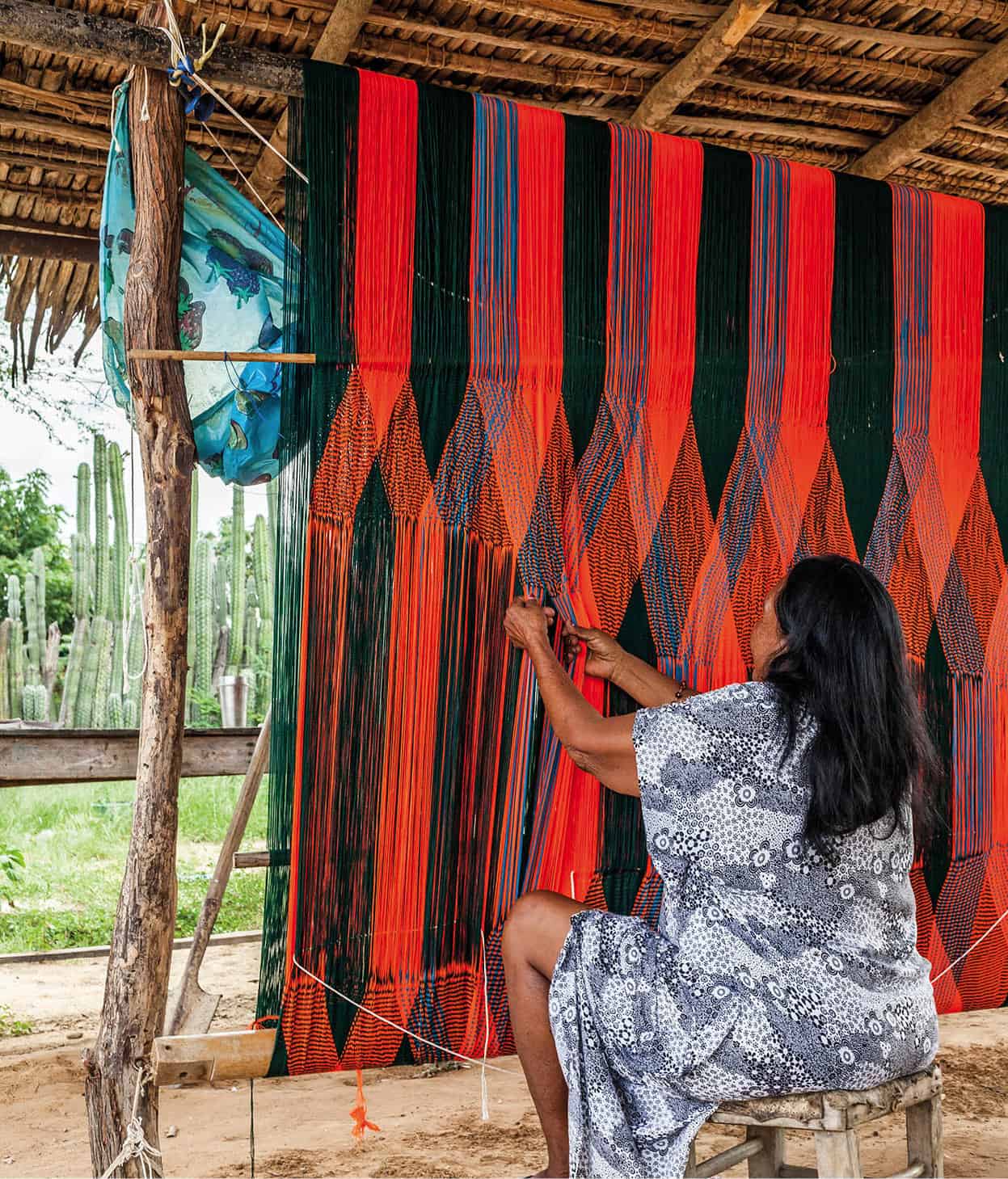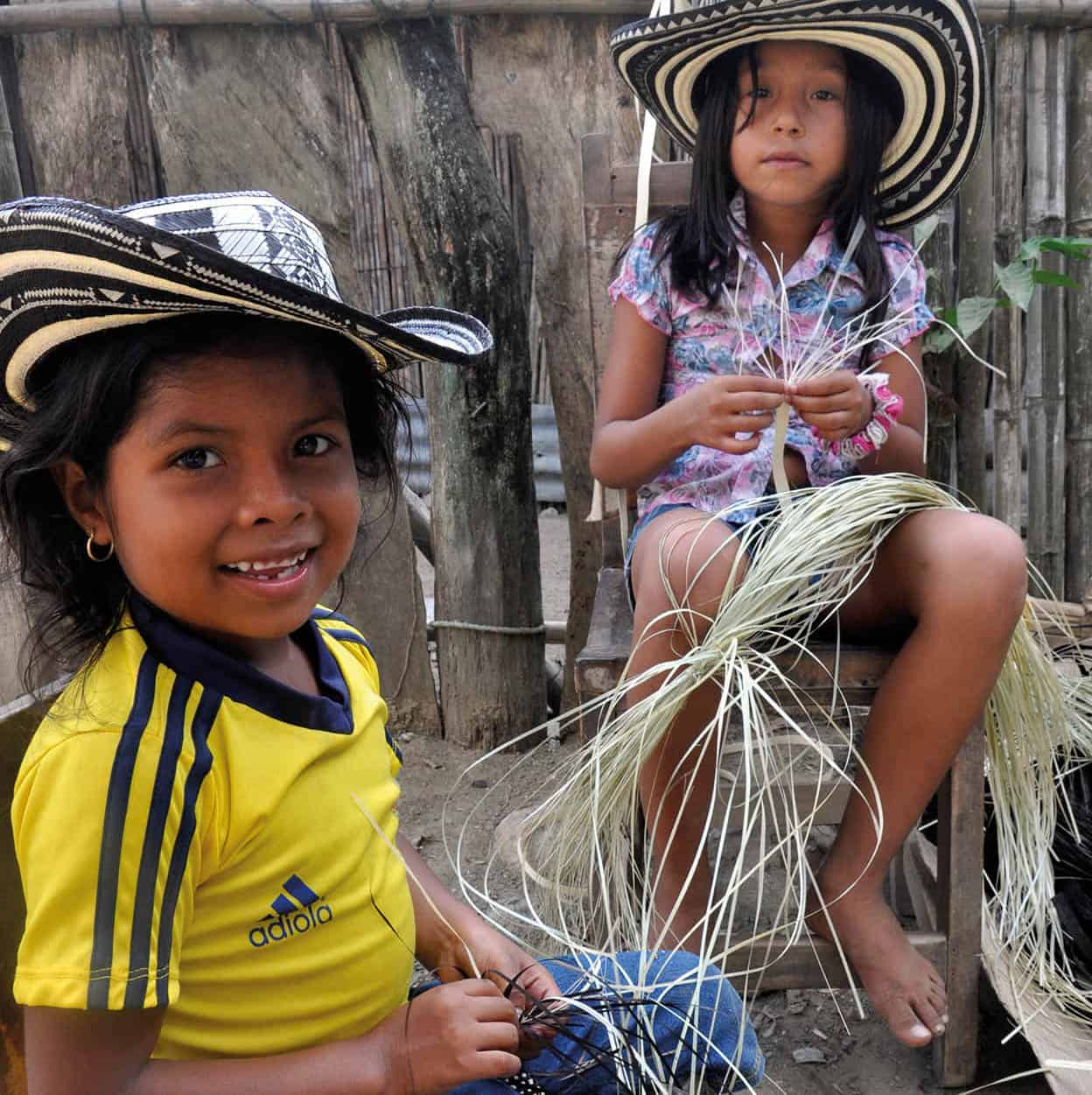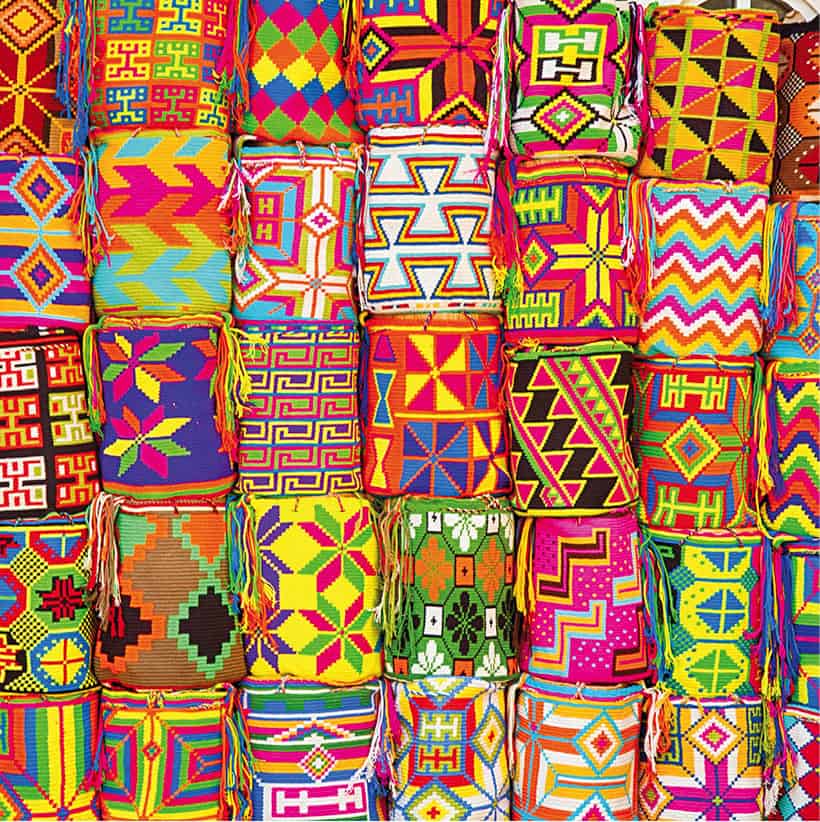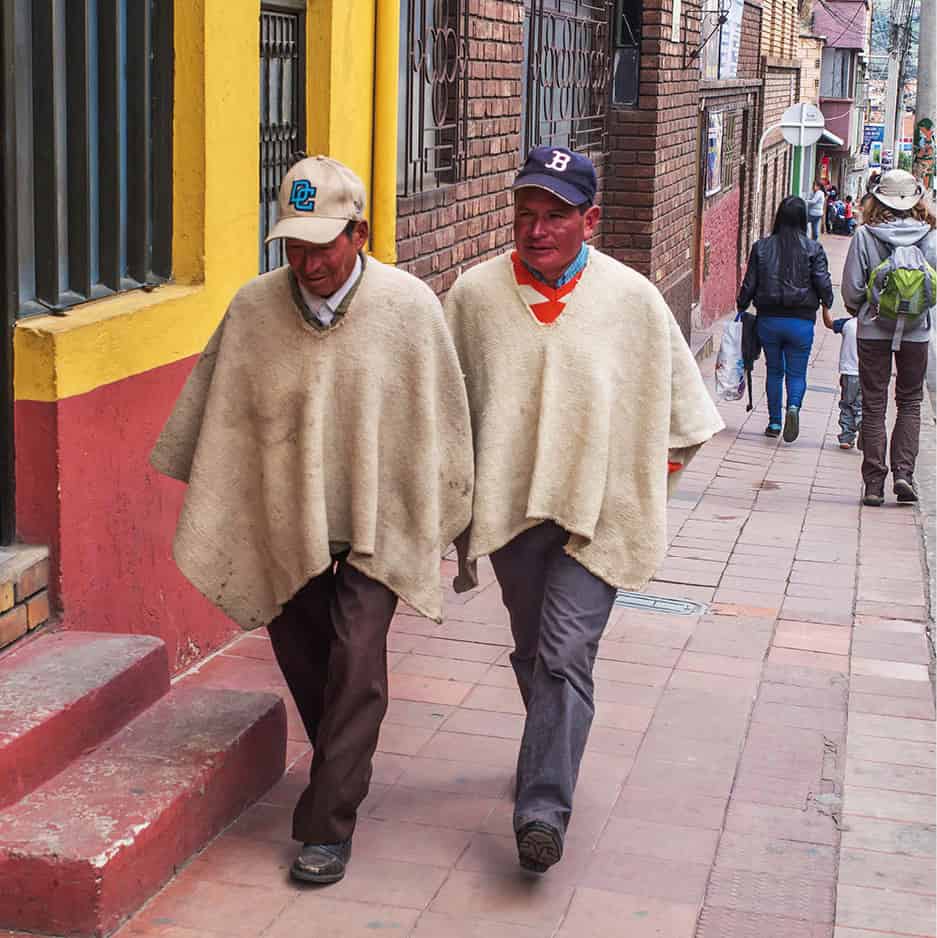Throughout Colombia you’ll find no shortage of traditional crafts. These products are abundant in the cities, and the farther you venture into rural areas, the more you’ll find entire communities whose economy revolves around the production and selling of crafts. Typically indigenous women will earn an income solely from making knit products, such as purses. These items represent more than money to the people who make them. They have a strong cultural significance deeply rooted in their native heritage. That’s why authentic Colombian crafts are in such high demand, because they are much more than the sum of their parts.

Wayúu indigenous woman weaving a chinchorro, a Colombian hammock.
Alamy
Sombrero vueltiao
The sombrero vueltiao is perhaps the most potent symbol of Colombian culture. It’s not hard to see why either: this wide-brimmed white hat, covered in black geometric patterns, is recognizable from a mile away. You may have seen them outside of Colombia too. Wherever there is a sizeable Colombian community in a foreign nation, the local politicians often pander to them by posing for photos in a sombrero vueltiao.

Children making sombreros vueltiaos in Tuchin.
Getty Images
The hat itself has deep cultural roots, deeper than you might think. It actually dates back 1,000 years or more, to the indigenous Zenú people on the Caribbean Coast. They are typically made of caña fleche fibers, which are derived from a tropical grass. Also, the patterns imprinted on the hat are not merely decorative – they symbolize many different aspects of the cosmology on which this indigenous group formed their religious beliefs. Some are under the impression that the iconic Juan Valdez character is typically seen wearing a sombrero vueltiao, but this is a misnomer. His hat is a sombrero aguadeño, named after its town of origin, Aguadas, in Caldas.
Mochila Wayúu
These bags are some of the most popular exports to fashion houses and stores across the globe. The craftsmanship is meticulous and the end result is an item of very high quality. Typically these bags are made from wild cotton and various other fibers. The process of making it involves twisting the fibers into z and s shapes, using a ganchillo, which is a crocheting technique. It’s a painstakingly slow process: it can often take around 20 days to produce just one bag.
As with many crafts in Colombia, the methodology of producing these bags has been passed down from generation to generation. For the Wayúu people of the Guajira Peninsula, the act of making the bags is an expression of life. Legend has it that there was once a gigantic spider, named Wale’Kerü, in the area that was having trouble maintaining a steady supply of food. So he taught the Wayúu how to knit these bags in exchange for animals. There are various types of these bags, but one of the most common is the susu. These days it’s seen on celebrities the world over.

Wayúu mochilas.
iStock
Ruana
The ruana is traditional piece of Colombian clothing from the Altiplano, which is made up of the highlands of Boyacá and Cudinamarca Departments. This is a type of poncho made from wool and designed to withstand the frigid temperatures typical of high altitude plateaus. These items are in demand as well, and in the town of Noba, in Boyacá, hundreds of families earn their living from the manufacture of ruanas. The proliferation of mass-produced ruanas means it can be easy to be duped into buying an inauthentic version. Therefore it’s best to head to these little communities and show your support by purchasing one whose artisan values win out in the end. Many of the families who make them still sheer the sheep with scissors and thread the garment using spindles, a worthy commitment to craftsmanship that deserves recognition.
Kuna crafts
There are so many beautiful crafts available from the various indigenous tribes in Colombia that seeing them all in one trip is an impossible task. However it’s precisely this variety that makes Colombia a prime destination for travelers seeking to purchase quality, authentic goods made with heart and soul. To this end, it’s best not to leave any indigenous stone unturned in the quest for great craftwork.
Enter the Kuna tribe. This indigenous group exists principally in areas of Panama, although there are some small communities in Colombia. Those who take the sailboat journey from Cartagena to Colon, in Panama (or vice versa), will be treated to a stop at the San Blas Archipelago of islands, where the Kuna have been living simply and off the land and sea, much as they’ve had for centuries.
They deal in trade, and one item travelers might come across is a mola, a traditional Kuna craft. Molas are multi-functional pieces of fabric with colorful designs that can be used as garments (they often form the front and back of dresses), or the coverings of bags.
Molas are perfect gifts for those who love crafting in their own right, as they can be sewn into pillows, furniture, cushions, and so on. You don’t even have to visit the San Blas Islands in order to find these artisanal gems. They are on offer in the markets of Capurganá, near the Panamanian border.
Guacamayas
Guacamaya is the name of a town in Boyacá as well as a type of basket that hails from the area. These multi-color baskets are made by hand and are known for their distinctive weave, which involves rolling the fiber around a stem and then rolling again on a spiral. With this technique artisans are able to make a variety of items including bowls, trays, and baskets of varying sizes.
Wérregue
This rare craft hails from the Chocó Department and is produced exclusively by women. The name derives from the Wérregue palm tree, whose leaves are woven so tight that they can even hold water, to form plates, bowls, pots and baskets. The original manufacturing process was brought to the area by missionary nuns hundreds of years ago, but the locals jazzed it up by adding flourishes of color and figures to the designs. Today wérregue crafts are distinct and famous products that are immediately known as being products of the Chocó.
If you are traveling toward the Ecuador/Peru border, then stop in at Putumayo Department. Here you’ll find handmade beaded jewelry from the indigenous tribes of the region. They typically incorporate jungle seeds to make colorful pieces of jewelry, such as necklaces and bracelets.
Filigree jewlery
In Colombia, you’ll notice the littler silver pieces of artisan jewelry, distinctive for their intricate and delicate designs that often resemble threads. In fact, the name derives from Latin, with filum meaning ‘thread.’ This technique of jewelry making is known as filigree, and despite existing throughout the world, from Europe to Asia and the Middle East, it was brought over to Colombia during colonial times by the Spanish.
This process of jewelry making first took hold in the Magdalena River towns on the Caribbean Coast. Much of the gold the Spanish had pilfered passed through here, so local artisans had an abundance of material to work with. Over time locals adapted the delicate techniques to make them uniquely Colombian.
The Colombian technique of making filigree jewelry involves producing various parts of the item to be connected later to form a whole, not unlike a puzzle. The artisans make the framework out of silver, forming the individual shapes one by one. So every shape, be it a heart or a flower, has to be put together by hand. The artisans of today use modern tools, such as soldering irons and pliers, but overall it’s a painstaking process that relies predominantly on the hands.
To create a piece of jewelry wholly from scratch is a good example of just how lengthy the process can be. The artisan starts with a chunk of silver, then melts it down to make the threads, before stretching them out until they reach the right size. This process can take a day to produce a single finished piece.

Men wearing ruanas in Tunja.
Alamy
Purchasing filigree jewelry in Colombia represents the age-old question of commercialism: do you buy handmade or mass-produced items? On the international market, the type of filigree jewelry made in Colombia takes a backseat to cheaper, mass-produced imports. However, everyone likes quality, so visitors to Colombia often purchase the real deal because they know the authenticity and level of craftsmanship involved. They might pay more, but they’re paying for a better product.
Still, authentic filigree pieces can be found at various prices. Some of the smallest pieces cost around US$5–10, while larger items like rings and bracelets can cost US$20–40. Larger and more intricate items can cost hundreds of dollars. Visitors to Bogotá should head to the markets at Usaquén to check out some authentic filigree jewelers.
One relevant organization well worth learning more about is Artesanias de Colombia (www.artesaniasdecolombia.com.co), which helps communities of artisan producers to monetize their items and turn their operations into sustainable businesses.

